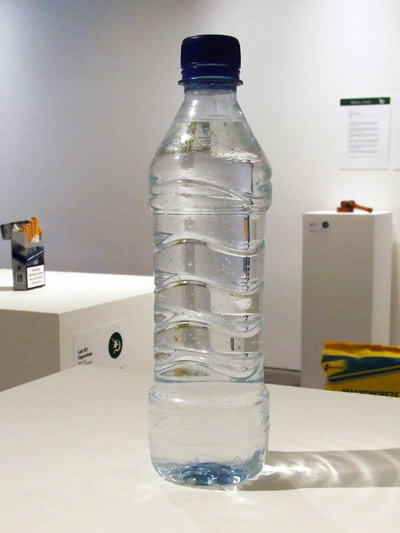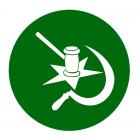joint projects
Lot 8


Bottled Water
Date: 2008 (bottle manufacture)
Contents: H2O with trace levels of fluoride in PET container
Lot Number 8 is a genuine example of late capitalist water contained in an original, scientifically-verified as sealed plastic container.
This ‘bottled water’* sold for 140 times the price of ‘tap water’ that was piped (at a fraction of the cost) into homes and premises throughout the industrialised nations of the time. Through careful testing we have discovered that tap water and bottled water turn out to be chemically identical. So why the high price?
In the UK, massive growth in the bottled water industry coincided with the privatisation of public water. Once commodified as a ‘liquid asset’ it quickly became a status symbol, particularly in the South East of the island, where requesting tap water in restaurants meant being seated next to the toilets.
New companies sprang up, bottling and advertising water as ‘hydration on the move’. A quarter of the UK’s bottled water was even transported from what was then known as France at great environmental cost by oil-consuming ‘combustion engine’ transportation.
Use of bottled water reached its peak during the 2012 Olympics, when hundreds of users drowned attempting to meet the sponsors challenge to ‘re-hydrate and lose weight’ by drinking 5 litres of bottled water a day.
* not to be confused with mineral water

Provenance
‘The biggest scam in marketing history, is how many see the bottled water industry. Certainly since its ‘invention’, producers have heavily invested in managing public perceptions of their product.
For example, the industry has sought to promote itself by undermining public confidence in tap water. In November 2008, Nick Krzyzaniak, head of bottled water company, Danone declared that drinking tap water is “a slightly scary proposition”. Krzyzaniak also raised the specter of “chemicals and other things being introduced”, making municipal water “much more susceptible to hormones, carcinogenics, and things.” 1
One bottled water company, Pepsi-owned Aquafina, was even forced to admit in 2008 that the water it had been marketing as “the taste of purity” was in fact simply tap water. This is now stated clearly on the label.2
Bottled water companies have also been keen to push the ‘two litres a day’ message to increase our daily intake of their product. However, in a review of scientific data published in 2008, US researchers found no evidence for such measures.
1 Martin Hickman, Troubled waters: Why we fell out of love with bottled water (and how the industry plans to win us back), The Independent, November 2008
2 Aquafina: www.spinprofiles.org/index.php/Aquafina